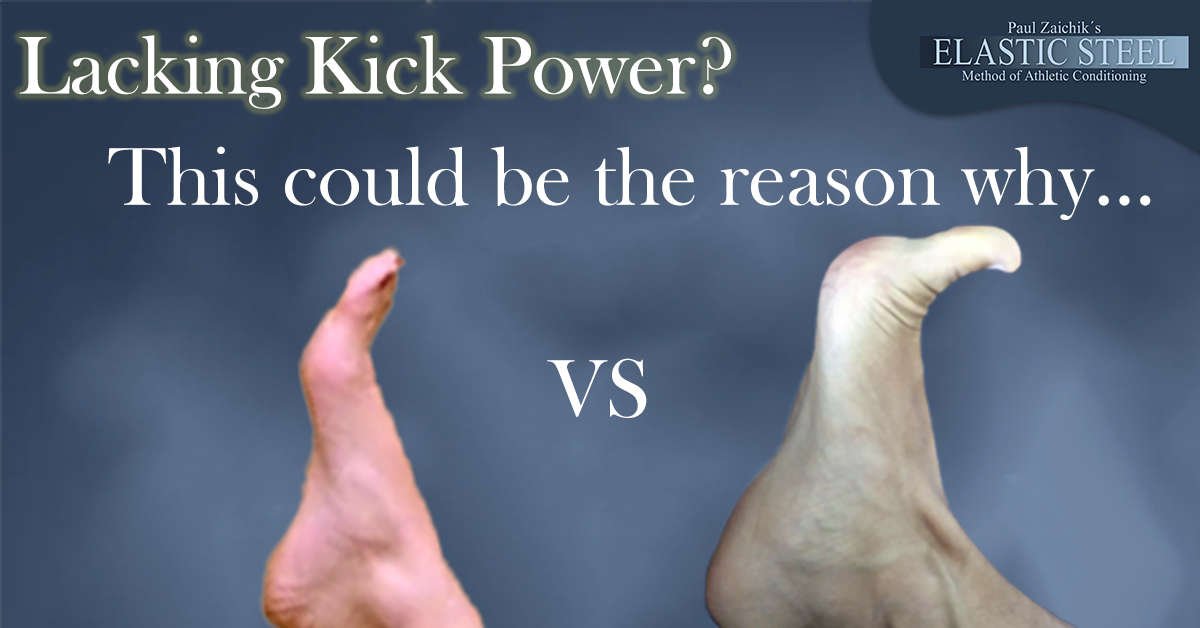Lacking Kick Power? This Could Be The Reason Why...

How to kick much harder with a small tweak and foot point of impact position.
I've been to many martial arts schools over the years and yet I haven't seen one which has focused training on developing the point of impact of a kick. Today you will understand why this is so important and why I personally wish every school would spend some time doing a lesson on developing the proper position of the foot.
Conditioning strength and flexibility exercises are common. Hips are developed, muscles of the thigh are developed. Muscles of the even lower leg developed through strength and flexibility exercises in majority of schools directly or indirectly. But the reality is that when a kick is thrown it must hit a target, and it must hit a target with specific part of the foot.
Of course, every beginner student will be shown when you do the front kick pull your toes back. When you do the sidekick point the heel edge of the foot. When you do the roundhouse pull back the toes, or perhaps move them into the same position as the front kick depending on your style, that is shown to every beginner.
After that the student is basically left on their own, at least where the point of impact is concerned. I'm going to share with you a story that will illustrate the importance of development of the foot.
Ball of the Foot
This program is designed to improve the strength and flexibility of feet and toes and present a perfect ball of the foot striking position. In simple terms you learn specialized training exercises to be able pull the toes back and toward you, while kicking. The goal of any ball of the foot kick is the same: to strike with the foot parallel to the target.
One person came over to me and said that something weird is happening to his kicks
In 2016 I spent a little bit of time going through different martial arts schools in the area demonstrating various techniques from ESKMS and from EFTC seminars. When I went to one particular school I did a lesson and at the end of the lesson, the instructor asked his students to ask me any questions that they had. And I had several people come over and ask me questions about their technique primarily about the kicks. One person came over to me and said that something weird is happening with his kicks. He said his right side is the stronger side. His roundhouse kick, side kick, hook kick, crescent kick and axe kick are stronger with his right leg and yet his front kick is weaker with his right leg and stronger with his left leg. I like mysteries, so I decided to see if I can answer his question and find the cause of the problem.
I like mysteries, so I decided to see if I can answer his question and find the cause of the problem.
I asked to see his front kick. His technique was the same on the left side and the right side. The right side did not exhibit a better technique in terms of acceleration, or range of motion of the joints, or timing of the kicks. His left and right side were even. This was a black belt and just in case I asked him if he practices his front leg or rear leg front kick with his left leg more and he said no he practices them the same.
Did he have any injuries?
My next question was about injuries because when a foot is injured, or any part of the body is injured a person will hold back. In this case it had to be the foot of the toes or the ankle because that's where the stress is on the front kick. He said he had no injuries.
Next, I decided to see if there's a neurological issue. If there is a problem with the motor neurons activation of course the kick is going to be weaker, and any technique is going to be weaker. So, when someone does a sideline kicks well but not frontline kicks sometimes their pectineus and the upper adductors have neurological issue. I asked him if there's any numbness or tingling in his lower abdomen or in his tight, he said no.
I isolated his adductors and asked for active internal rotation to see if maybe the nerves are not firing properly. He had good active internal rotation the same on the left as on the right. I then asked him to extend the front kick and hold it. Sometimes when there is a neurological issue, the leg that is affected will hold the kick lower. And sometimes the knee will not extend all the way, but he didn't have those issues either.
What about his hamstring flexibility?
Finally I decided to check his hamstring flexibility perhaps his hamstring was pulling back his quadriceps, and not allowing for the full power in his right leg. But his right hamstring was actually more flexible than the left so that was not a problem either.
Next, I asked for a pad and I had him kick the pad while I was holding it with his front kick and I did notice that his left leg front kick did penetrate quite a bit more than the right leg front kick. And this of course seemed strange because the kick was the same when he did it in the air.
I thought to myself that perhaps his left quadriceps is naturally stronger somehow. To test this, I asked one of the students for the belt and I tested the circumference. His right thigh turned out to be bigger, muscle wise then his left. However, that didn’t give me an answer.
Once again, I asked him if he had any injuries, any pain in any part of his leg or foot. He said no. So, I asked him to do the kicks again. And again, the technique was the same when he was performing the kick in the air, very good kicker.
Ball of the Foot
This program is designed to improve the strength and flexibility of feet and toes and present a perfect ball of the foot striking position. In simple terms you learn specialized training exercises to be able pull the toes back and toward you, while kicking. The goal of any ball of the foot kick is the same: to strike with the foot parallel to the target.
I notice that the trajectory of the right leg kick would change at the point of impact while trajectory of the left leg kick continued the same way the foot was accelerated
Again I took the pad and asked him to kick me through the pad and he did and again the left leg kick was stronger. So wanting to see the kick from the side I ask another student to hold a pad and he hit the pad while another student was holding it and now I notice that the trajectory of the right leg kick would change at the point of impact while trajectory of the left leg kick continued the same way the foot was accelerated.
It had to be the point of impact because there was nothing else that came up in the testing. He was wearing martial arts shoes and I asked him to pull back his toes which he did and it looked to me like the toes on the left foot were pulled back a little bit more but I wasn't 100% sure with the shoes. So I asked him if he can remove the shoes and I realized that he wasn't very comfortable with what I asked him to do. And also the way the instructor that invited me to the school looked at me, I realized that there's something there about the shoes, because very few students had the shoes on, most students for barefoot.
So I ask the student to go with me away from the group and I said to him that I need to see his feet but if she can't take off the shoes that is OK. he said that he had a condition and at the same time he is not comfortable placing his bare feet on the floor so he prefers not to take off his shoes.
I was barefoot and I said to him “Look you see the front kick point of impact how much my toes are pulled back?”
I was barefoot and I said to him:
“Look you see the front kick point of impact how much my toes are pulled back?”
“Look you see the front kick point of impact how much my toes are pulled back?”
I have very good flexibility in my toes so I can pull them back very high. I said “You see how much they are pulled back? But they can be pulled back like this” and I showed a little bit less.
I said to him that “I have a suspicion that your left foot you’re pulling back the toes more, then the right foot and that changes the trajectory of the kick. You’re trying to protect your toes and that's taking away the power of the right leg kick. If you don't mind can you go to the bathroom by yourself and just take off your shoes and look at your toes. And see if there is a difference in the toe position because again I suspect that you have more flexibility in the toes of the left foot. So if you don't mind go ahead and then come back let me know.”
So, he went to the bathroom came back and said “Yes! My left toes are a lot more flexible than my right ones. Do you think that it really could make such a difference in the front kick power?”
I said “Yes absolutely because it's like you’re accelerating your foot one way in a specific line and then your mass is behind in a specific line and then you must travels in a certain way and then your foot travels slightly different and of course it takes away from the power. If you do a palm strike and your palm is not flexible you will have to change the position of your arm and that's going to take off a lot of power and the same thing happens when you have a lack of
flexibility in the toes.”
flexibility in the toes.”
I showed him a few exercises to improve his point of impact.
Ball of the foot – Point of Impact alone, without doing anything else,
can increase the power of the front kick.
can increase the power of the front kick.
What happened that day would be a good example to a lot of people who do not quite understand why the flexibility of the foot is so important. Perhaps in the future I'll make an anatomical video with biomechanics of this and demonstrate why biomechanically, the mobility of the toes is so important. For this precise reason I’ve created a program called “Ball of the Foot – Point of Impact” which helps with this issue. I believe that most martial artists unless they really have a lot of flexibility in the toes, can benefit from this program, and it will without doing anything else, increase the power of the front kick.
Ball of the Foot
This program is designed to improve the strength and flexibility of feet and toes and present a perfect ball of the foot striking position. In simple terms you learn specialized training exercises to be able pull the toes back and toward you, while kicking. The goal of any ball of the foot kick is the same: to strike with the foot parallel to the target.
© Ideas presented here are original to the Author and may not be plagiarized, copied, etc., without the written permission by the author. ElasticSteel Corp., EasyFlexibility, Paul Zaichik, et. El., 2022. No part of the materials available through ElasticSteel.com, EasyFlexiiblity.com, site may be copied, photocopied, reproduced, translated or reduced to any electronic medium or machine-readable form, in whole or in part, without prior written consent of Paul Zaichik EasyFlexibility.com, Elasticsteel.com.. Any other reproduction in any form without the permission of Paul Zaichik EasyFlexibility.com, Elasticsteel.com is prohibited. All materials contained on this site are protected by United States copyright law and may not be reproduced, distributed, transmitted, displayed, published or broadcast without the prior written permission of Paul Zaichik, EasyFlexibility.com, Elasticsteel.com.





Leave a comment